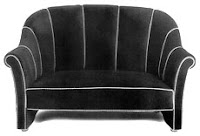


















Panton’s furniture immediately makes me think of the Jetson’s cartoon. The designs are obscure and are an experiment in science fiction or futuristic form. His chairs come in all sorts of shapes and colours, and he also uses a large variety in materials. He would go from making a chair that is entirely bent wood, and then use a combination of fabric, foam and metal on the next design. The chair he is most known for is his Panton Chair which was the “First single unit cantilevered chair made of moulded plastic” - vernerpanton.com.










As a furniture designer, Josef Hoffman could be described as being between the Arts and Craft, and Modern design movements. His furniture’s style is very heavy or cumbersome and also ornamented which is just the opposite of what we would call Modern Design. The materials he selected for the sofas and armchairs, mostly wood and leather or cotton also reflect the Arts and Crafts movement. His work was clearly an influence on the modernist movement because simple geometric shapes like cubes and circles are the dominating characteristic in the forms, and he was not opposed to using machines to fabricate his work.




